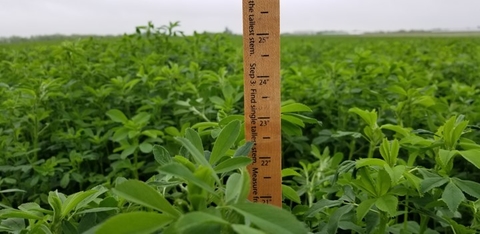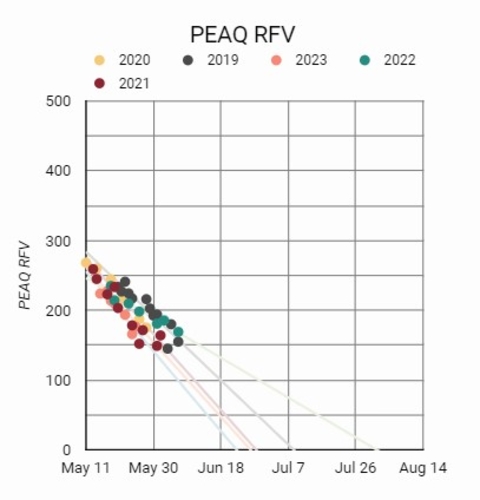You can estimate alfalfa relative feed value (RFV) and neutral detergent fiber (NDF) levels with the Predictive Equations for Alfalfa Quality (PEAQ) system, which gives alfalfa producers a simple way to schedule harvests. A PEAQ stick can be a useful tool when implementing this approach (Figure 1).
The PEAQ stick is currently used in the central Minnesota Harvest Alert/Scissor Cut Program and example results are shown in Figure 2. The PEAQ stick method was developed by the University of Wisconsin. Sticks can be purchased through the Midwest Forage Association RFV PEAQ stick order form.
How to sample using the PEAQ method
This procedure is most accurate for good stands of pure alfalfa with healthy growth. Follow these steps:
- Choose a representative 2-square-foot area in the field.
- Determine the most mature stem in the 2-square-foot sampling area using the staging criteria shown in Table 1.
- Measure the length of the tallest stem in the 2-square-foot area. Measure it from the soil surface (next to plant crown) to the tip of the stem (not to the tip of the highest leaf blade). Straighten the stem to accurately measure its length. The tallest stem may not be the most mature stem.
- Based on the most mature stem and length of the tallest stem, use Table 1 to determine the standing alfalfa forage’s estimated RFV content. NDF can be estimated using Table 2.
- Repeat steps 1 to 4 in four or five representative areas across the field. For fields larger than 30 acres, sample more times.
Estimating alfalfa relative feed value (RFV)
The PEAQ sampling procedure estimates alfalfa RFV of the standing crop based on alfalfa maturity and height. It doesn't account for changes in quality due to wilting, harvesting and storage. These factors may further lower RFV by 15 to 25 points, assuming good wilting and harvesting conditions.
The general recommendation is to harvest when the PEAQ estimate is 15 to 25 RFV points higher than what you want to have in the feed bunk.
Table 1. PEAQ stick estimate of relative feed value (RFV) using alfalfa stem height and maturity stage.
| Height | Late vegetative | Bud stage | Flower stage |
|---|---|---|---|
| 16 inches | 237 RFV | 225 RFV | 210 RFV |
| 17 inches | 230 RFV | 218 RFV | 204 RFV |
| 18 inches | 224 RFV | 212 RFV | 198 RFV |
| 19 inches | 217 RFV | 207 RFV | 193 RFV |
| 20 inches | 211 RFV | 201 RFV | 188 RFV |
| 21 inches | 205 RFV | 196 RFV | 183 RFV |
| 22 inches | 200 RFV | 190 RFV | 178 RFV |
| 23 inches | 195 RFV | 185 RFV | 174 RFV |
| 24 inches | 190 RFV | 181 RFV | 170 RFV |
| 25 inches | 185 RFV | 176 RFV | 166 RFV |
| 26 inches | 180 RFV | 172 RFV | 162 RFV |
| 27 inches | 175 RFV | 168 RFV | 158 RFV |
| 28 inches | 171 RFV | 164 RFV | 154 RFV |
| 29 inches | 167 RFV | 160 RFV | 151 RFV |
| 30 inches | 163 RFV | 156 RFV | 147 RFV |
| 31 inches | 159 RFV | 152 RFV | 144 RFV |
| 32 inches | 155 RFV | 149 RFV | 140 RFV |
| 33 inches | 152 RFV | 145 RFV | 137 RFV |
| 34 inches | 148 RFV | 142 RFV | 134 RFV |
| 35 inches | 145 RFV | 139 RFV | 131 RFV |
| 36 inches | 142 RFV | 136 RFV | 128 RFV |
| 37 inches | 138 RFV | 133 RFV | 126 RFV |
| 38 inches | 135 RFV | 130 RFV | 123 RFV |
| 39 inches | 132 RFV | 127 RFV | 121 RFV |
| 40 inches | 129 RFV | 124 RFV | 118 RFV |
NOTE: Quality factors are generally expected to change each day: RFV declines 3 to 4 units per day; Relative forage quality (RFQ) declines 4 to 5 units per day.
Estimating alfalfa neutral detergent fiber (NDF)
The PEAQ sampling procedure estimates alfalfa NDF content of the standing crop. It doesn’t account for changes in quality due to wilting, harvesting and storage. These factors may further raise NDF content by three to six units, assuming good wilting and harvesting conditions.
Table 2. PEAQ stick estimate of neutral detergent fiber (NDF) using alfalfa stem height and maturity stage.
| Length of tallest stem | Late vegetative | Bud stage | Flower stage |
|---|---|---|---|
| 16 inches | 28.5% NDF | 29.7% NDF | 31.4% NDF |
| 17 inches | 29.2% NDF | 30.4% NDF | 32.0% NDF |
| 18 inches | 29.9% NDF | 31.1% NDF | 32.7% NDF |
| 19 inches | 30.6% NDF | 31.8% NDF | 33.4% NDF |
| 20 inches | 31.3% NDF | 32.5% NDF | 34.1% NDF |
| 21 inches | 32.0% NDF | 33.2% NDF | 34.8% NDF |
| 22 inches | 32.7% NDF | 33.9% NDF | 35.5% NDF |
| 23 inches | 33.4% NDF | 34.6% NDF | 36.2% NDF |
| 24 inches | 34.0% NDF | 35.3% NDF | 36.9% NDF |
| 25 inches | 34.7% NDF | 35.9% NDF | 37.6% NDF |
| 26 inches | 35.4% NDF | 36.6% NDF | 38.3% NDF |
| 27 inches | 36.1% NDF | 37.3% NDF | 38.9% NDF |
| 28 inches | 36.8% NDF | 38.0% NDF | 39.6% NDF |
| 29 inches | 37.5% NDF | 38.7% NDF | 40.3% NDF |
| 30 inches | 38.2% NDF | 39.4% NDF | 41.0% NDF |
| 31 inches | 38.9% NDF | 40.1% NDF | 41.7% NDF |
| 32 inches | 39.6% NDF | 40.8% NDF | 42.4% NDF |
| 33 inches | 40.3% NDF | 41.5% NDF | 43.1% NDF |
| 34 inches | 40.9% NDF | 42.2% NDF | 43.8% NDF |
| 35 inches | 41.6% NDF | 42.8% NDF | 44.5% NDF |
| 36 inches | 42.3% NDF | 43.5% NDF | 45.2% NDF |
| 37 inches | 43.0% NDF | 44.2% NDF | 45.8% NDF |
| 38 inches | 43.7% NDF | 44.9% NDF | 46.5% NDF |
| 39 inches | 44.4% NDF | 45.6% NDF | 47.2% NDF |
| 40 inches | 45.1% NDF | 46.3% NDF | 47.9% NDF |
Reviewed in 2023



